This section introduces you to some of the occurrences of the Fibonacci series and the Golden Ratio in architecture, art and music.
1·61803 39887 49894 84820 45868 34365 63811 77203
09179 80576 ..More..
![]()
Even from the time of the Greeks, a rectangle whose sides are in the golden proportion (1 : 1.618 which is the same as 0.618 : 1) has been known since it occurs naturally in some of the proportions of the Five Platonic Solids (as we have already seen) and a construction for the golden section point is found in Euclid's Elements in this connection. This rectangle is supposed to appear in many of the proportions of that famous ancient Greek temple, the Parthenon, in the Acropolis in Athens, Greece but there is no original documentary evidence that this was how the building was designed. (There is a replica of the original building (accurate to one-eighth of an inch!) at Nashville which calls itself "The Athens of South USA".)
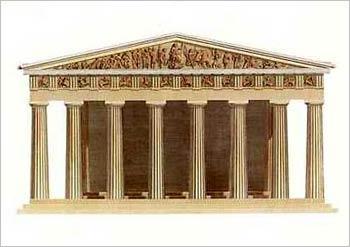 Greek Temples (HC) Stuart Revett Buy This Art Print At AllPosters.com |
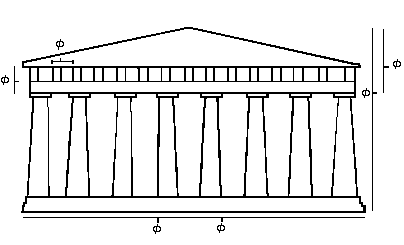 |
| The Panthenon image here shows clear golden sections in the placing of the three horizontal lines but the overall shape and the other prominent features are not golden section ratios. | 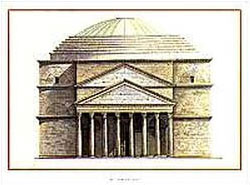 // Saved as
"Pantheon" file // Saved as
"Pantheon" file Pantheon, Libero Patrignani |
| There is a wonderful collection of pictures of the Parthenon and the Acropolis at Indiana University's web site. | |
| Dr Ann M Nicgorski of the Department of Art and Art History at Williamette University in the USA has a large collection of links to Parthenon pictures with many details of the building. | |
| David Silverman's page on the Parthenon has lots of information. Look at the plan of the Parthenon. The dividing partition in the inner temple seems to be on the golden section both of the main temple and the inner temple. Apart from that, I cannot see any other clear golden sections - can you? | |
| Allan T Kohl's Art Images for College Teaching has a lot of images on ancient art and architecture. |

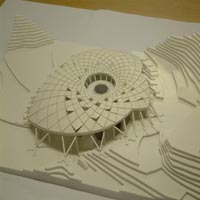 The Eden Project in St. Austell, between Plymouth and Penzance in SW England and
50 miles from Land's End, has some wonderfully impressive greenhouses based on
geodesic domes (called biomes) built in an old quarry.
The Eden Project in St. Austell, between Plymouth and Penzance in SW England and
50 miles from Land's End, has some wonderfully impressive greenhouses based on
geodesic domes (called biomes) built in an old quarry. 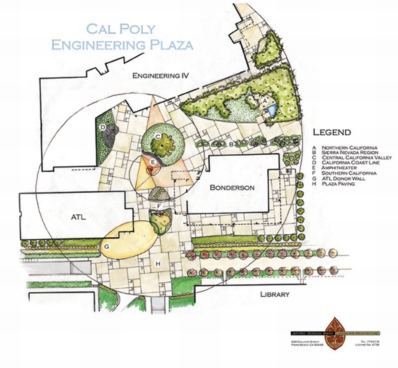 The
College of Engineering at the California Polytechnic State University have plans for a new
Engineering
Plaza based on the Fibonacci numbers and several geometric diagrams you will
also have seen on other pages here. There is also a page of images
of the new building.
The
College of Engineering at the California Polytechnic State University have plans for a new
Engineering
Plaza based on the Fibonacci numbers and several geometric diagrams you will
also have seen on other pages here. There is also a page of images
of the new building. As a guiding element, we selected the Fibonacci series spiral, or golden mean, as the representation of engineering knowledge.The start of construction is currently planned for late 2005 or early in 2006.
The architect Le Corbusier deliberately incorporated some golden rectangles as the shapes of windows or other aspects of buildings he designed. One of these (not designed by Le Corbusier) is the United Nations building in New York which is L-shaped. Although you will read in some books that "the upright part of the L has sides in the golden ratio, and there are distinctive marks on this taller part which divide the height by the golden ratio", when I looked at photos of the building, I could not find these measurements. Can you?
 An aerial
view
An aerial
view | University of
Wisconsin's Library of Art History images is an excellent source of architecture images and well worth checking out! It has many images of the Parthenon, pictures of its friezes and other details. Use their searcher selecting the Period Ancient Greece: Classical and the Site Athens. Note: the images cannot be copied or even made into links, only viewed on their page! | |
| June
Komisar's page of architectural links from the University of Michigan.
She points to the Great Building Collection which has some excellent photo images on their Parthenon page. Do check this out as they have a FREE 3D viewer to download and lots of buildings in 3D to view. You can take your own virtual walk through the Parthenon! | |
| The Kings Tomb in Egypt and the golden section. |
0, 1, 1, 2, 3, 5, 8, 13, 21, 34, 55, 89, 144, 233,
377, 610, 987 ..More..
![]()
| A |
We have seen on earlier pages at this site that this gives two ratios, AM:AB which is also BM:AM and is 0.618... which we call phi (beginning with a small p). The other ratio is AB:AM = AM:MB = 1/phi= 1.618... or Phi (note the capital P). Both of these are variously called the golden number or golden ratio, golden section, golden mean or the divine proportion. Other pages at this site explain a lot more about it and its amazing mathematical properties and it relation to the Fibonacci Numbers.Pacioli's work influenced Leonardo da Vinci (1452-1519) and Albrecht Durer (1471-1528) and is seen in some of the work of Georges Seurat, Paul Signac and Mondrian, for instance.
 Many books on oil painting and water colour in your local
library will point out that it is better to position objects not in the centre
of the picture but to one side or "about one-third" of the way across, and to
use lines which divide the picture into thirds. This seems to make the picture
design more pleasing to the eye and relies again on the idea of the golden
section being "ideal".
Many books on oil painting and water colour in your local
library will point out that it is better to position objects not in the centre
of the picture but to one side or "about one-third" of the way across, and to
use lines which divide the picture into thirds. This seems to make the picture
design more pleasing to the eye and relies again on the idea of the golden
section being "ideal".


| A ray traced image based on Fibonacci spirals and rectangles | |
| the Web Museum pages on Durer, Famous Painting Virtual Exhibition. their long list of famous artists and their works. | |
| There is a very useful set of mathematical links to Art and Music web resources from Mathematics Archives that is worth looking at. |
| Top9.com's List of the top art sources on the web is an excellent place for links to good art sources on the web. Highly recommended! | |
| The Metropolitan Museum of Art in New York houses more than 2 million works of art. | |
| The Fine Arts Museums of San Francisco site has an Image base of 65,000 works of art. It includes art from Ancient to Modern, from paintings to ceramics and textiles, from all over the world as well as America. | |
| A Guide to Art Collections in the UK | |
| Michelangelo is
famous for his paintings (such as the ceiling in the Sistine
Chapel) and his sculptures (for instance David). This site has
links to several sources and images of his works and some links to sites
on the golden section. Using the picture of his David sculpture, measure it and see if he has used Phi - eg is the navel ("belly button") 0·618 of the David's height? | |
| Why not visit the Leonardo Museum in the town of
Vinci (Italy) itself from which town Leonardo is named, of
course. There are many sketches and paintings of Leonardo's at The WebMuseum, Paris too. |
| Billie Ruth Sudduth is a North American artist specialising in basket work that is now internationally known. Her designs are based on the Fibonacci Numbers and the golden section - see her web page JABOBs (Just A Bunch Of Baskets). Mathematics Teaching in the Middle School has a good online introduction to her work (January 1999). | |
| Kees van Prooijen of California has used a similar series to the Fibonacci series - one made from adding the previous three terms, as a basis for his art. | |
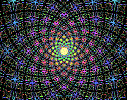 Ned May has generated some beautiful
pictures based on Fibonacci Spirals using Visual Basic (an example is
shown here on the right). Ned May has generated some beautiful
pictures based on Fibonacci Spirals using Visual Basic (an example is
shown here on the right). |
| Pietro Malusardi and Karen Wallace have a web page showing some elegant applications of the golden section in furniture design. | |
| Custom Furniture Solutions have a Media cabinet designed using golden section proportions. | |
| A recent edition (Jan/Feb 2003) of the Ancient Egypt Magazine contained an article on Woodworking in Ancient Egypt where the author, Geoffrey Killen, explains how a box (chest) exhibits the golden section in its design but is not sure if this is coincidence or design. | |
| Fletcher Cox is a craftsman in wood who has used the golden section in his birds-eye maple wooden plate. |
0, 1, 1, 2, 3, 5, 8, 13, 21, 34, 55, 89, 144, 233,
377, 610, 987 ..More..
![]()
1·61803 39887 49894 84820 45868 34365 63811 77203
09179 80576 ..More..
![]()
Twinkle twinkle little starAlso we have the rhythm of the separate sounds (called syllables). Words like twinkle have two syllables: twin- and -kle whereas words such as star have just one. Some syllables are emphasized or stressed more than others so that they sound louder (such as TWIN- in twinkle), whereas others are unstressed and quieter (such as -kle in twinkle). Dictionaries will often show how to pronounce a word by separating it into syllables, the stressed parts shown in capital as we have done here, e.g. DIC-tion-ar-y to show it has 4 syllables with the first one only being stressed.
How I wonder what you are.
Up above the world, so high
Like a diamond in the sky
...
In Sanskrit poetry syllables are are either long or short.
In English we
notice this in some words but not generally - all the syllables in the song
above take about the same length of time to say whether they are stressed or
not, so all the lines take the same amount of time to say.
However cloudy
sky has two words and three syllables CLOW-dee SKY, but the first and
third syllables are stressed and take a longer to say then the other
syllable.
Let's assume that long syllables take just twice as long to say as
short ones.
So we can ask the question:
For one time unit, we have only one short syllable to say: S = 1 way
For two time units, we can have two short or one long
syllable: SS and L = 2 ways
For three units, we can
have: SSS, SL or LS = 3 ways
Any guesses for lines of
4 time units? Four would seem reasonable - but wrong! It's five!
SSSS, SSL,
SLS, LSS and LL;
the general answer is that lines that take n time units to
say can be formed in Fib(n) ways.
This was noticed by Acarya Hemacandra about 1150 AD or 70 years before Fibonacci published his first edition of Liber Abaci in 1202!
![]() Acarya Hemacandra and the (so-called) Fibonacci Numbers Int. J. of
Mathematical Education vol 20 (1986) pages 28-30.
Acarya Hemacandra and the (so-called) Fibonacci Numbers Int. J. of
Mathematical Education vol 20 (1986) pages 28-30.
1·61803 39887 49894 84820 45868 34365 63811 77203
09179 80576 ..More..
![]()
Trudi H Garland's [see below] points out that on the 5-tone scale (the black notes on the piano), the 8-tone scale (the white notes on the piano) and the 13-notes scale (a complete octave in semitones, with the two notes an octave apart included). However, this is bending the truth a little, since to get both 8 and 13, we have to count the same note twice (C...C in both cases). Yes, it is called an octave, because we usually sing or play the 8th note which completes the cycle by repeating the starting note "an octave higher" and perhaps sounds more pleasing to the ear. But there are really only 12 different notes in our octave, not 13!
Various composers have used the Fibonacci numbers when composing music - more details in Garland's book.
Baginsky's method of constructing violins is also based on golden sections.
![]() The
Mathematics Magazine Vol 68 No. 4, pages 275-282, October 1995 has an
article by Putz on Mozart and the Golden section in his music.
The
Mathematics Magazine Vol 68 No. 4, pages 275-282, October 1995 has an
article by Putz on Mozart and the Golden section in his music.
| Duality and Synthesis in the Music of Bela Bartók by E Lendvai on pages 174-193 of Module, Proportion, Symmetry, Rhythm G Kepes (editor), George Brazille, 1966; | |
| Some striking Proportions in the Music of Bela Bartók in Fibonacci Quarterly Vol 9, part 5, 1971, pages 527-528 and 536-537. | |
| Bela
Bartók: an analysis of his music by Erno Lendvai, published by Kahn & Averill, 1971; has a more detailed look at Bartók's use of the golden mean. | |
| Debussy
in Proportion - a musical analysis by Roy Howat, Cambridge Univ. Press,1983, ISBN = 0 521 23282 1. | |
| Concert pianist Roy Howat's Web site has more information on his Debussy in Proportion book and others works and links. | |
| Adams, Coutney S. Erik Satie and Golden Section Analysis.
in Music and Letters, Oxford University Press,ISSN 0227-4224, Volume 77, Number 2 (May 1996), pages 242-252 | |
| Schubert Studies, (editor Brian Newbould) London: Ashgate
Press, 1998 has a chapter Architecture as drama in late Schubert by Roy Howat, pages 168 - 192, about Schubert's golden sections in his late A major sonata (D.959). | |
| The Proportional Design of J.S. Bach's Two Italian
Cantatas, Tushaar Power, Musical Praxis, Vol.1, No.2. Autumn 1994, pp.35-46. This is part of the author's Ph D Thesis J.S. Bach and the Divine Proportion presented at Duke University's Music Department in March 2000. | |
| Proportions in Music by Hugo Norden in Fibonacci
Quarterly vol 2 (1964) pages 219-222 talks about the first fugue in J S Bach's The Art of Fugue and shows how both the Fibonacci and Lucas numbers appear in its organization. | |
| Per Nřrgĺrd's 'Canon' by Hugo Norden in Fibonacci Quarterly vol 14 (1976), pages 126-128 says the title piece is an "example of music based entirely and to the minutest detail on the Fibonacci Numbers". |
1After the first two lines, all the others are made from the two latest lines in a similar way to each Fibonacci numbers being a sum of the two before it. Each string (list of 0s and 1s) here is a copy of the one above it followed by the one above that. The resulting infintely long string is the Golden String or Fibonacci Word or Rabbit Sequence. It is interesting to hear it in musical form and I give two ways in the section Hear the Golden sequence on that page. In that same section I mention the London based group Perfect Fifth who have used it in a piece called Fibonacci that you can hear online too .
10
101
10110
10110101
1011010110110
101101011011010110101
...

1·61803 39887 49894 84820 45868 34365 63811 77203
09179 80576 ..More..
![]()
 Joerg Wiegels of Duesseldorf told me that he was astonished to
see the Fibonacci numbers glowing brightly in the night sky on a visit to Turku
in Finland. The chimney of the Turku
power station has the Fibonacci numbers on it in 2 metre high neon lights!
It was the first commission of the Turku City
Environmental Art Project in 1994. The artist, Mario Merz (Italy) calls it
Fibonacci Sequence 1-55 and says "it is a metaphor of the human quest for
order and harmony among chaos."
Joerg Wiegels of Duesseldorf told me that he was astonished to
see the Fibonacci numbers glowing brightly in the night sky on a visit to Turku
in Finland. The chimney of the Turku
power station has the Fibonacci numbers on it in 2 metre high neon lights!
It was the first commission of the Turku City
Environmental Art Project in 1994. The artist, Mario Merz (Italy) calls it
Fibonacci Sequence 1-55 and says "it is a metaphor of the human quest for
order and harmony among chaos."
The picture here was taken by Dr. Ching-Kuang Shene of Michigan Technological University and is reproduced here with his kind permission from his page of photos of his Finland trip.
 |
 |
 |
 |
1·61803 39887 49894 84820 45868 34365 63811 77203
09179 80576 ..More..
![]()
So this page has lots of speculative material on it and would make a good Project for a Science Fair perhaps, investigating if the golden section does account for some major design features in important works of art, whether architecture, paintings, sculpture, music or poetry. It's over to you on this one!
| George Markowsky's Misconceptions about the Golden ratio in The College Mathematics Journal Vol 23, January 1992, pages 2-19 is an important article that points out the weaknesses in parts of "the golden-section is the most pleasing shape" theory. This is readable and well presented. Perhaps too many people just take the (unsupportable?) remarks of others and incorporate them in their works? You may or may not agree with all that Markowsky says, but this is a good article which tries to debunk a simplistic and unscientific "cult" status being attached to Phi, seeing it where it really is not! This is not to deny that Phi certainly is genuinely present in much of botany and the mathematical reasons for this are explained on earlier pages at this site. | |
| How to Find the "Golden Number" without really trying Roger Fischler, Fibonacci Quarterly, 1981, Vol 19, pages 406 - 410. Another important paper that points out how taking measurements and averaging them will almost always produce an average near Phi. Case studies are data about the Great Pyramid of Cheops and the various theories propounded to explain its dimensions, the golden section in architecture, its use by Le Corbusier and Seurat and in the visual arts. He concludes that several of the works that purport to show Phi was used are, in fact, fallacious and "without any foundation whatever". | |
| The Fibonacci Drawing Board Design of the Great Pyramid of
Gizeh Col. R S Beard in Fibonacci Quarterly vol 6, 1968, pages
85 - 87; has three separate theories (only one of which involves the golden section) which agree quite well with the dimensions as measured in 1880. | |
| Golden Section(ism): From mathematics to the theory of art and
musicology, Part 1, Dénes Nagy in Symmetry, Culture and
Science, volume 7, number 4, 1996, pages 337-448 Section 2.1 says there are at least nine different theories about the shape of the Great Pyramid of Pharoah Khufu (the Great Pyramid of Cheops), two of which refer to the golden section: The angle of the slope of the faces is
|
| Key: | ||
|---|---|---|
| a book | ||
| an article in a magazine or a paper in an academic journal | ||
| a website | ||
| Fascinating
Fibonaccis by Trudi Hammel Garland, Dale Seymours publications, 1987 is an excellent introduction to the Fibonacci series with lots of useful ideas for the classroom. Includes a section on Music. | |
| An example of Fibonacci Numbers used to Generate Rhythmic Values in
Modern Music in Fibonacci Quarterly Vol 9, part 4, 1971, pages 423-426; |
Other music

Gamelan
is the percussion oriented music of Indonesia. The American Gamelan Institute has lots of information including a Gongcast recorded online music so you can hear Gamelan music for yourself.New music
from David Canright of the Maths Dept at the Naval Postgraduate School in Monterey, USA; combining the Fibonacci series with Indonesian Gamelan musical forms.Some CDs
on Gamelan music of Central Java (the country not the software!).
Art

Martin Morgenstern has a large and interesting list of books and articles on the golden section and music with abstracts, some of which is in German. The Fibonacci Sequence
is the name of a classical music ensemble of internationally famous soloists, who are the musicians in residence at Kingston University (Kingston-upon-Thames, Surrey, UK). Based in the London (UK) area, their current programme of events is on the Web site link above.
Casey Mongoven is a composer who has used Fibonacci numbers and golden sections in his own classical music. You can hear it and read more on his web site.

A Mathematical History of the Golden Number by Roger Herz-Fischler, Dover 1998, ISBN 0486400077. A scholarly study of all major references in an attempt to trace the earliest references to the "golden section", its names, etc. 
Education through Art (3rd edition) H Read,
Pantheon books,1956, pages 14-22;The New Landscape in Art and Science G Kepes
P Theobald and Co, 1956, pages 329 and 294;H E Huntley's, The Divine Proportion: A study in mathematical beauty,
ISBN 0-486-22254-3 is a 1970 Dover reprint of an old classic.C. F. Linn, The Golden Mean: Mathematics and the Fine Arts,
Doubleday 1974.
Gyorgy Doczi, The Power of Limits: Proportional Harmonies in Nature, Art, and Architecture
Shambala Press, (new edition 1994).
M. Boles, The Golden Relationship: Art, Math, Nature, 2nd ed.,
Pythagorean Press 1987.
WHERE TO NOW??? This is the last page on |
The next topics... |